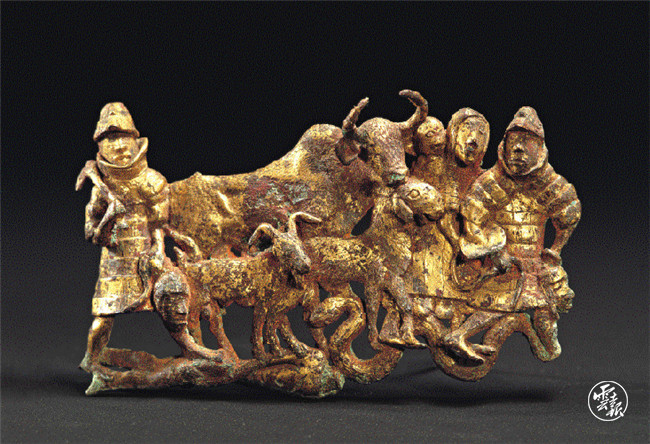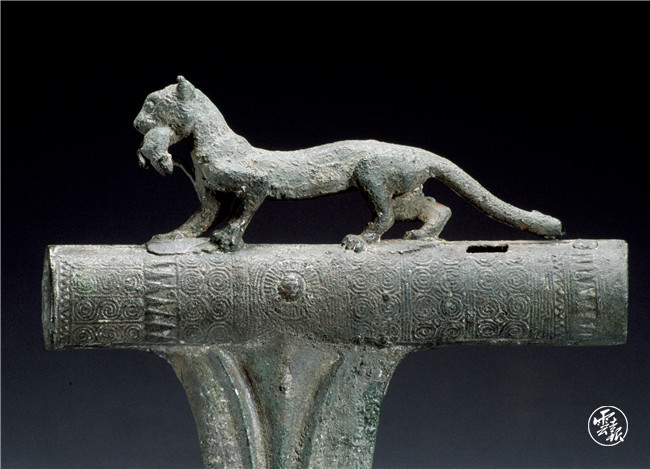Zhao Yun: Bronze wares show biodiversity in ancient Yunnan

A gilded bronze buckle shows two ancient Dian soldiers with their preys of ox, goat, sheep and woman in between. (Yunnan Provincial Museum/Xing Yi)
“The animal-themed bronze wares collected in Yunnan Provincial Museum belong to the unique ones among their Chinese peers, and they in a way have showcased the biodiversity in ancient Yunnan, or the Dian kingdom,” said Zhao Yun, associate researcher at the museum.
Also working for the Yunnan branch of National Relics Exit-Entry Administration, Zhao said this in a recent interview on the occasion of the 15th meeting of the Conference of the Parties to the UN Convention on Biological Diversity (COP15) in Kunming, Yunnan province. The first part of the meeting was finished earlier this year in October, with the latter part to be convened in 2022.
Dubbed as “Kingdoms of animals and plants” and “World’s Gene Bank”, Yunnan is the most biologically diverse province in China and the southwest ecological shield for the country. In recent years, the province has been committed to green development, gaining exceptional achievements in protecting biodiversity and building ecological civilization.

A treasure container shows a tiger-ox fighting scene with onlookers of monkeys and birds. (Yunnan Provincial Museum/Xing Yi)
Animal diversity in lush environment
Zhao said animal patterns cast on the museum’s bronze wares mirrored the eco-environment of the ancient Dian kingdom around 2,000 years ago. “The area of the museum exhibits typical animal-themed bronze wares from the Warring States Period (770-476BCE) to the early Western Han Dynasty (202BCE-8AD), involving horse, dog, fox, fish, peacock, frog, cobra, python, monkey, red deer, pelican and others.”
Used as weapons, farming tools and sacrificial utensils, Zhao explained, the bronze wares were decorated with preying tigers and masculine buffalos, as well as goats, boars and pangolins in diverse postures. “The scenes on the wares show the ancient Dian folks lived in a lush but wild eco-environment, haunted by beasts and selected by nature.”
Manifesting the man-nature/animal coexistence in harmony in the ancient Dain kingdom, Zhao noted, the bronze wares showed the Dian folks worshiped animals, instead of regarding animals as something at their disposal.
Through close observation, Zhao said, we could see the animal diversity in the ancient kingdom of Dian or Yunnan. The cattle figures on the wares involved the Asian bison, the African buffalo and the zebu in ancient India, all invisible in Yunnan now. The giant boars cast on the bronze wares, looking strong and wild, dared to fight against tigers, leopards or serpents. And such boars almost went extinction.

A bronze-buckle decoration shows a boar falls into prey of two tigers. (Yunnan Provincial Museum/Xing Yi)
Abstruse writing by animal patterns
Other researchers at the Yunnan museum also noticed that animal figures abounded on the sacrificial utensils, which were probably used as divine instruments to link up the heaven and the earth.
“Our ancient Dian forefathers used animal figures to form a sort of abstruse writing,” said Zhao, pointing to a bronze ware that resembles a paper sheet. Studies at the museum showed the special writing was interpreted like this:
“Oh, my lord! In praying for your grace, I hereby offer you pheasant and jade bracelets… In the battle, we captured 100 hogs, 20 goats and 70 oxen. I take the most pride in this feast and will remember it for good.”
In interpreting the scripture-like materials via hermeneutics, Zhao added, we can further figure out the living environment of the ancient Dian people, as well as the biodiversity history of the Yunnan kingdom back then.

A treasure container shows a gilded knight guarded by four oxen. (Yunnan Provincial Museum/Xing Yi)
Meaningful animal fights
The desperate fighting scenes among animals were cast here and there on the bronze wares: the boar-leopard fight, the eagle-snake tussle, the ox-tiger battle appeared on buckles, ritual utensils, scepters and more.
Zhao pointed out that such scenes vividly showed the biodiversity of the ancient Dian kingdom in specific terms. Because of the complete food-chain and sound eco-systems back then, naturalistic fights or killings were commonplace in the animal realm.
From the historical point of view, Zhao said the fighting scenes reflected the animal totems of ethnic groups. “Some worshiped tigers, others worshiped oxen. The fighting scenes seemingly tell the conflicts and wars among local ethnic groups.”
Another interpretation for the animal fights on the bronze wares is that the ancient Dian folks revered strength and they probably felt a sense of beauty in the wilderness, or an anarchic state of affairs.

A preying leopard is cast on a bronze peck. (Yunnan Provincial Museum/Xing Yi)
Reporting by Li Hongfeng (Yunnan Daily); Trans-editing by Wang Shixue